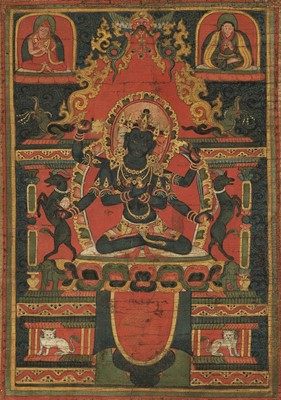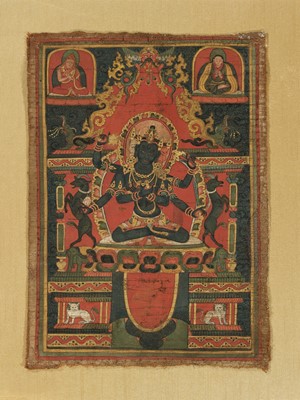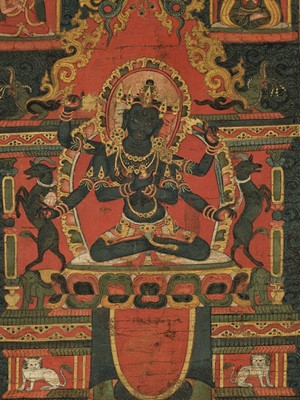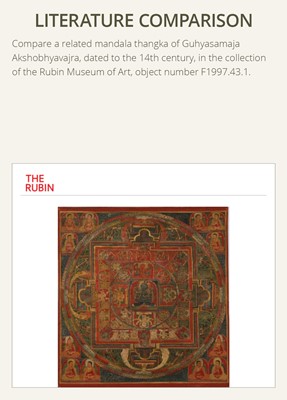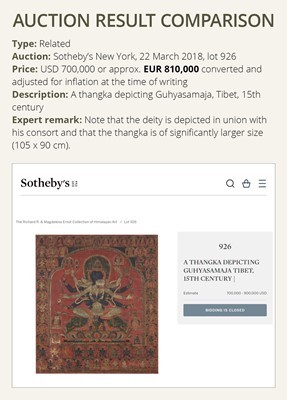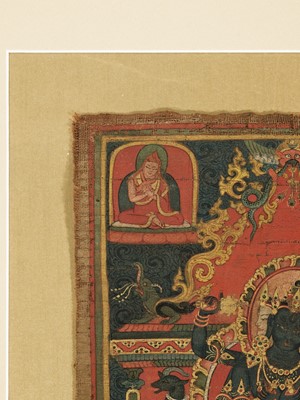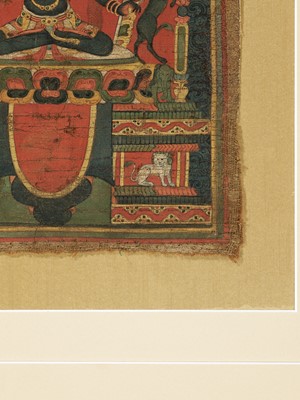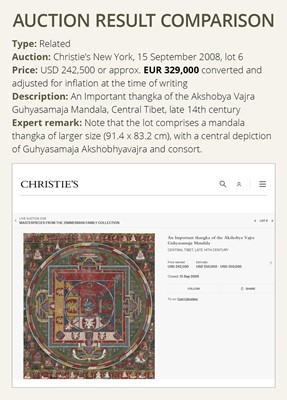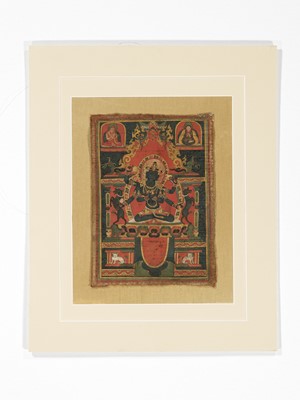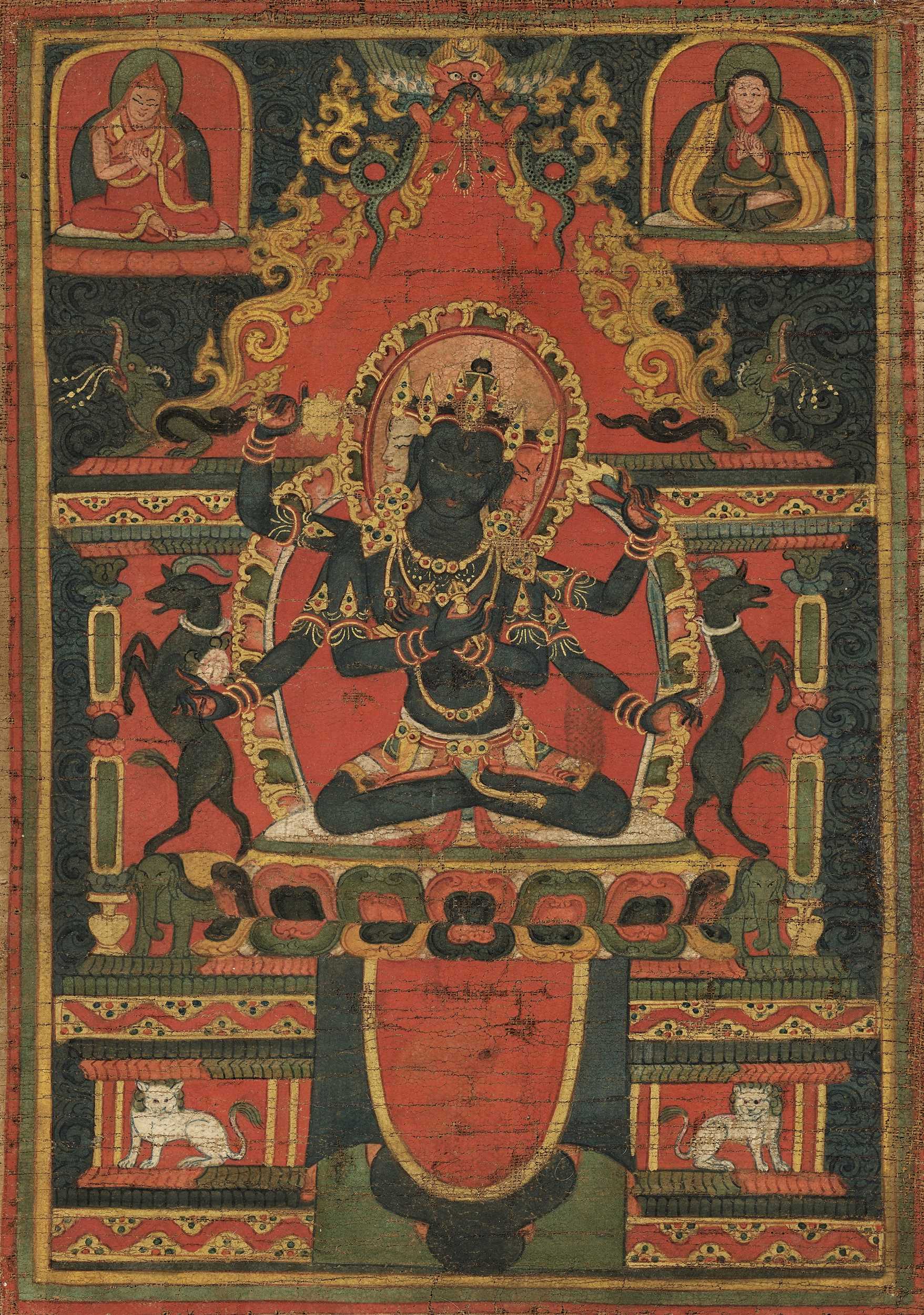29th Sep, 2022 13:00
DAY 1 - TWO-DAY AUCTION - Fine Chinese Art / 中國藝術集珍 / Buddhism & Hinduism
183
AN EARLY THANGKA OF GUHYASAMAJA AKSHOBHYAVAJRA, 13TH-14TH CENTURY
十三至十四世紀密集不動金剛唐卡
Sold for €16,900
including Buyer's Premium
Central Tibet. Distemper and gilt on cloth. Superbly painted with the dark-blue, three-headed, and six-armed deity at the center, seated in dhyanasana on a lotus pillow atop a tiered throne supported by snow lions, backed by a lotus-petaled mandorla and halo. He is holding ritual implements including vajra, ghanta, padma, chakra, and khadga, and richly adorned with elaborate gold jewelry.
Provenance: Daffos & Estournel, Paris, 2004. A private collection in Milan, Italy, acquired from the above. Leonardo Vigorelli, Bergamo, acquired from the above. Leonardo Vigorelli is a retired Italian art dealer and noted collector, specializing in African and ancient Hindu-Buddhist art. After studying anthropology and decades of travel as well as extensive field research in India, the Himalayan region, Southeast Asia, and Africa, he founded the Dalton Somaré art gallery in Milan, Italy, which today is being run by his two sons.
Condition: Very good condition, commensurate with age, with some old wear, creasing, minor losses and aging to pigments, few loose threads, possibly microscopic touch-ups here and there. The painting laid down on textile and double-matted. Presenting very well overall.
Dimensions: Image size 27.7 x 20.1 cm, Size incl. mounting 49.2 x 40 cm
Guhyasamaja Akshobhyavajra is flanked by two goats standing on elephants. The throne arch is topped by Garuda holding a naga in his mouth, flanked by two lamas in the upper register.
The Guhyasamaja Tantra is one of the most important scriptures of Tantric Buddhism, written in Sanskrit. In the practice of the Arya Tradition, the central deity of the Guhyasamaja is the blue-black Akṣhobhyavajra, a form of Akshobhya, one of the five tathagathas, sometimes called the dhyani buddhas. Akṣobhyavajra holds a vajra and bell (ghanta) in his first two hands, and his other hands hold the symbols of the four other tathagathas: The wheel of Vairocana and the lotus of Amitabha in his rights, and the gem of Ratnasambhava and the sword of Amoghasiddhi in his lefts.
Expert’s note: Rarely is this iconographic subject so clearly delineated, allowing the viewer to follow the contours of the body, examine hands and ritual implements silhouetted against the red background, and to gaze upon the otherworldly countenance of Guhyasamaja.
Literature comparison:
Compare a related mandala thangka of Guhyasamaja Akshobhyavajra, dated to the 14th century, in the collection of the Rubin Museum of Art, object number F1997.43.1.
Auction result comparison:
Type: Related
Auction: Sotheby’s New York, 22 March 2018, lot 926
Estimate: USD 700,000 or approx. EUR 810,000 converted and adjusted for inflation at the time of writing
Description: A thangka depicting Guhyasamaja, Tibet, 15th century
Expert remark: Note that the deity is depicted in union with his consort and that the thangka is of significantly larger size (105 x 90 cm).
Auction result comparison:
Type: Related
Auction: Christie’s New York, 15 September 2008, lot 6
Price: USD 242,500 or approx. EUR 329,000 converted and adjusted for inflation at the time of writing
Description: An Important thangka of the Akshobya Vajra Guhyasamaja Mandala, Central Tibet, late 14th century
Expert remark: Note that the lot comprises a mandala thangka of larger size (91.4 x 83.2 cm), with a central depiction of Guhyasamaja Akshobhyavajra and consort.
十三至十四世紀密集不動金剛唐卡
西藏中部。布面膠畫描金。主尊軀體為藍色,頭戴五葉冠,象徵五佛或五菩薩,結跏趺坐在蓮台。有六隻手臂,都持有法物,並分別拿金剛杵、金剛鈴、法輪、匕首與噴焰摩尼,後有光背。
來源:巴黎Daffos & Estournel,2004年;義大利米蘭私人收藏;貝加莫Leonardo Vigorelli購於上述收藏。Leonardo Vigorelli是一位退休的義大利藝術品經銷商和著名收藏家,專門研究非洲和古代印度教佛教藝術。在學習人類學和數十年的旅行以及在印度、喜馬拉雅地區、東南亞和非洲的廣泛實地研究之後,他在義大利米蘭創立了 Dalton Somaré 藝術畫廊,如今由他的兩個兒子經營。
品相:狀況極好,有一些磨損、摺痕、輕微缺損和顏料老化,些微鬆散的線,有輕微修飾。這幅畫鋪在紡織品上,並經過雙重處理。
尺寸:畫面27.7 x 20.1 厘米,總49.2 x 40 厘米
密集不動金剛的兩側是兩隻站在大象上的山羊。寶座拱頂上是迦樓羅,嘴裡叼著一條蛇,兩側分別爲喇嘛。
專家注釋:這樣的唐卡非常少見,觀者可以如此欣賞密集金剛的超凡脫俗的面貌。
文獻比較:
比較一件相近十四世紀密集不動金剛曼陀羅唐卡,收藏於Rubin藝術博物館,館藏編號F1997.43.1。
拍賣結果比較:
形制:相近
拍賣:紐約蘇富比,2018年3月22日,lot 926
估價:USD 700,000(相當於今日EUR 810,000)
描述:西藏十五世紀密集不動金剛唐卡
專家評論:請注意此唐卡描繪密集金剛與祂的妃子,且尺寸明顯較大(105 x 90 厘米)。
拍賣結果比較:
形制:相近
拍賣:紐約佳士得,2008年9月15日,lot 6
價格:USD 242,500(相當於今日EUR 329,000)
描述:十四世紀晚期西藏中部曼陀羅密集不動金剛唐卡
專家評論:請注意此唐卡四周為曼陀羅,中央為密集不動金剛和祂的妃子,且尺寸較大(91.4 x 83.2 厘米)。
Central Tibet. Distemper and gilt on cloth. Superbly painted with the dark-blue, three-headed, and six-armed deity at the center, seated in dhyanasana on a lotus pillow atop a tiered throne supported by snow lions, backed by a lotus-petaled mandorla and halo. He is holding ritual implements including vajra, ghanta, padma, chakra, and khadga, and richly adorned with elaborate gold jewelry.
Provenance: Daffos & Estournel, Paris, 2004. A private collection in Milan, Italy, acquired from the above. Leonardo Vigorelli, Bergamo, acquired from the above. Leonardo Vigorelli is a retired Italian art dealer and noted collector, specializing in African and ancient Hindu-Buddhist art. After studying anthropology and decades of travel as well as extensive field research in India, the Himalayan region, Southeast Asia, and Africa, he founded the Dalton Somaré art gallery in Milan, Italy, which today is being run by his two sons.
Condition: Very good condition, commensurate with age, with some old wear, creasing, minor losses and aging to pigments, few loose threads, possibly microscopic touch-ups here and there. The painting laid down on textile and double-matted. Presenting very well overall.
Dimensions: Image size 27.7 x 20.1 cm, Size incl. mounting 49.2 x 40 cm
Guhyasamaja Akshobhyavajra is flanked by two goats standing on elephants. The throne arch is topped by Garuda holding a naga in his mouth, flanked by two lamas in the upper register.
The Guhyasamaja Tantra is one of the most important scriptures of Tantric Buddhism, written in Sanskrit. In the practice of the Arya Tradition, the central deity of the Guhyasamaja is the blue-black Akṣhobhyavajra, a form of Akshobhya, one of the five tathagathas, sometimes called the dhyani buddhas. Akṣobhyavajra holds a vajra and bell (ghanta) in his first two hands, and his other hands hold the symbols of the four other tathagathas: The wheel of Vairocana and the lotus of Amitabha in his rights, and the gem of Ratnasambhava and the sword of Amoghasiddhi in his lefts.
Expert’s note: Rarely is this iconographic subject so clearly delineated, allowing the viewer to follow the contours of the body, examine hands and ritual implements silhouetted against the red background, and to gaze upon the otherworldly countenance of Guhyasamaja.
Literature comparison:
Compare a related mandala thangka of Guhyasamaja Akshobhyavajra, dated to the 14th century, in the collection of the Rubin Museum of Art, object number F1997.43.1.
Auction result comparison:
Type: Related
Auction: Sotheby’s New York, 22 March 2018, lot 926
Estimate: USD 700,000 or approx. EUR 810,000 converted and adjusted for inflation at the time of writing
Description: A thangka depicting Guhyasamaja, Tibet, 15th century
Expert remark: Note that the deity is depicted in union with his consort and that the thangka is of significantly larger size (105 x 90 cm).
Auction result comparison:
Type: Related
Auction: Christie’s New York, 15 September 2008, lot 6
Price: USD 242,500 or approx. EUR 329,000 converted and adjusted for inflation at the time of writing
Description: An Important thangka of the Akshobya Vajra Guhyasamaja Mandala, Central Tibet, late 14th century
Expert remark: Note that the lot comprises a mandala thangka of larger size (91.4 x 83.2 cm), with a central depiction of Guhyasamaja Akshobhyavajra and consort.
十三至十四世紀密集不動金剛唐卡
西藏中部。布面膠畫描金。主尊軀體為藍色,頭戴五葉冠,象徵五佛或五菩薩,結跏趺坐在蓮台。有六隻手臂,都持有法物,並分別拿金剛杵、金剛鈴、法輪、匕首與噴焰摩尼,後有光背。
來源:巴黎Daffos & Estournel,2004年;義大利米蘭私人收藏;貝加莫Leonardo Vigorelli購於上述收藏。Leonardo Vigorelli是一位退休的義大利藝術品經銷商和著名收藏家,專門研究非洲和古代印度教佛教藝術。在學習人類學和數十年的旅行以及在印度、喜馬拉雅地區、東南亞和非洲的廣泛實地研究之後,他在義大利米蘭創立了 Dalton Somaré 藝術畫廊,如今由他的兩個兒子經營。
品相:狀況極好,有一些磨損、摺痕、輕微缺損和顏料老化,些微鬆散的線,有輕微修飾。這幅畫鋪在紡織品上,並經過雙重處理。
尺寸:畫面27.7 x 20.1 厘米,總49.2 x 40 厘米
密集不動金剛的兩側是兩隻站在大象上的山羊。寶座拱頂上是迦樓羅,嘴裡叼著一條蛇,兩側分別爲喇嘛。
專家注釋:這樣的唐卡非常少見,觀者可以如此欣賞密集金剛的超凡脫俗的面貌。
文獻比較:
比較一件相近十四世紀密集不動金剛曼陀羅唐卡,收藏於Rubin藝術博物館,館藏編號F1997.43.1。
拍賣結果比較:
形制:相近
拍賣:紐約蘇富比,2018年3月22日,lot 926
估價:USD 700,000(相當於今日EUR 810,000)
描述:西藏十五世紀密集不動金剛唐卡
專家評論:請注意此唐卡描繪密集金剛與祂的妃子,且尺寸明顯較大(105 x 90 厘米)。
拍賣結果比較:
形制:相近
拍賣:紐約佳士得,2008年9月15日,lot 6
價格:USD 242,500(相當於今日EUR 329,000)
描述:十四世紀晚期西藏中部曼陀羅密集不動金剛唐卡
專家評論:請注意此唐卡四周為曼陀羅,中央為密集不動金剛和祂的妃子,且尺寸較大(91.4 x 83.2 厘米)。
Zacke Live Online Bidding
Our online bidding platform makes it easier than ever to bid in our auctions! When you bid through our website, you can take advantage of our premium buyer's terms without incurring any additional online bidding surcharges.
To bid live online, you'll need to create an online account. Once your account is created and your identity is verified, you can register to bid in an auction up to 12 hours before the auction begins.
Intended Spend and Bid Limits
When you register to bid in an online auction, you will need to share your intended maximum spending budget for the auction. We will then review your intended spend and set a bid limit for you. Once you have pre-registered for a live online auction, you can see your intended spend and bid limit by going to 'Account Settings' and clicking on 'Live Bidding Registrations'.
Your bid limit will be the maximum amount you can bid during the auction. Your bid limit is for the hammer price and is not affected by the buyer’s premium and VAT. For example, if you have a bid limit of €1,000 and place two winning bids for €300 and €200, then you will only be able to bid €500 for the rest of the auction. If you try to place a bid that is higher than €500, you will not be able to do so.
Online Absentee and Telephone Bids
You can now leave absentee and telephone bids on our website!
Absentee Bidding
Once you've created an account and your identity is verified, you can leave your absentee bid directly on the lot page. We will contact you when your bids have been confirmed.
Telephone Bidding
Once you've created an account and your identity is verified, you can leave telephone bids online. We will contact you when your bids have been confirmed.
Classic Absentee and Telephone Bidding Form
You can still submit absentee and telephone bids by email or fax if you prefer. Simply fill out the Absentee Bidding/Telephone bidding form and return it to us by email at office@zacke.at or by fax at +43 (1) 532 04 52 20. You can download the PDF from our Upcoming Auctions page.
How-To Guides
How to Create Your Personal Zacke Account
How to Register to Bid on Zacke Live
How to Leave Absentee Bids Online
How to Leave Telephone Bids Online
中文版本的操作指南
创建新账号
注册Zacke Live在线直播竞拍(免平台费)
缺席投标和电话投标
Third-Party Bidding
We partner with best-in-class third-party partners to make it easy for you to bid online in the channel of your choice. Please note that if you bid with one of our third-party online partners, then there will be a live bidding surcharge on top of your final purchase price. You can find all of our fees here. Here's a full list of our third-party partners:
- 51 Bid Live
- EpaiLive
- ArtFoxLive
- Invaluable
- LiveAuctioneers
- the-saleroom
- lot-tissimo
- Drouot
Please note that we place different auctions on different platforms. For example, in general, we only place Chinese art auctions on 51 Bid Live.
Bidding in Person
You must register to bid in person and will be assigned a paddle at the auction. Please contact us at office@zacke.at or +43 (1) 532 04 52 for the latest local health and safety guidelines.
